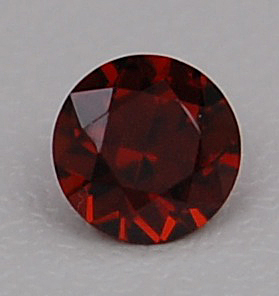
Introduction: Almandine, also spelled as almandite, is a species in the garnet family.
Colors: reddish-orange to red, typically dark in tone
Clarity: Almandine garnets are of clarity Type II. Gems in this type typically grow with some minor inclusions in nature that may be eye visible but usually are well hidden or require magnification. Needle-like crystals, zircon crystals with strain halos and irregular, rounded crystals of low relief are commonly seen under magnification.
Stone Sizes: Almandine has been cut into large sizes (over 20 ct) but larger stones tend to be too dark. Most almandines within the trade are less than 10 ct.
Localities:
-India, Sri Lanka, Brazil, Madagascar, Mozambique
-Idaho: the source of star garnets showing a weak 4 ray (rarely six ray) star
Treatments: None
Gemology:
-Refractive Index: 1.790 (+/-0.030)
-Birefringence: None (singly refractive)
-Optic Character: Singly refractive, often shows anomalous double refraction (ADR)
-Dispersion: 0.024
-Specific Gravity: 4.05 (+0.25,-0.12)
Hardness: 7-7.5
Toughness: fair to good
-Chemical Composition: Fe3Al2(SiO4)3
-Cause of Color: iron
-Absorption Spectra: usually three strong bands at 5040, 5200 and 5730; may also show fainter lines at
4230, 4600, 6100 and 6800-6900
-Fluorescence: None
-Cleavage: None
-Phenomena: Star
Name: Almandine is a corruption of the locality name Alabanda, in Asia Minor, from which place that red garnets were described by Pliny.
Dates: All species of garnets can be used as the birthstone for January. Garnets are also the gem of choice for second anniversaries.
Care: Ultrasonics are usually safe but risky with liquid inclusions. Steam cleaners should never be used. The safest method for cleaning is with warm soapy water. Abrupt temperature changes will likely cause fracturing.
To see available almandines, click here. (None currently available)